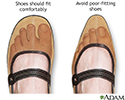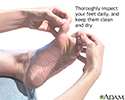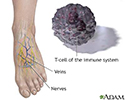Diabetes - taking care of your feet
Diabetes - foot care - self-care; Diabetic foot ulcer - foot care; Diabetic neuropathy - foot care
Self-care
Diabetes can damage the nerves and blood vessels in your feet. This damage can cause numbness and reduce feeling in your feet. As a result, your feet may not heal well if they are injured. If you get a blister, you may not notice and it may get worse.
Diabetes
Diabetes is a chronic disease in which the body cannot regulate the amount of sugar in the blood.

Check your feet every day. Inspect the tops, sides, soles, heels, and between your toes. Look for:
- Dry and cracked skin
- Blisters or sores
- Bruises or cuts
- Redness, warmth, or tenderness
- Firm or hard spots
If you cannot see well, ask someone else to check your feet.
Call your health care provider right way about any foot problems you have. DO NOT try to treat these problems yourself. Even small sores or blisters can become big problems if infection develops or they DO NOT heal. Foot ulcers are a common reason for hospital stays for people with diabetes.
Foot ulcers
If you have diabetes, you have an increased chance of developing foot sores, or ulcers, also called diabetic ulcers. Foot ulcers are a common reason ...
Wash your feet every day with lukewarm water and mild soap. Strong soaps may damage the skin.
- Check the temperature of the water with your hand or elbow first.
- Gently dry your feet, especially between the toes.
- Use lotion, petroleum jelly, lanolin, or oil on dry skin. DO NOT put lotion, oil, or cream between your toes.
Ask your health care provider to show you how to trim your toenails.
- Soak your feet in lukewarm water to soften your toenails before trimming.
- Cut the nails straight across. Curved nails are more likely to become ingrown.
- Make sure the edge of each nail does not press into the skin of the next toe.
Your foot doctor (podiatrist) can trim your toenails if you are unable to.
Most people with diabetes should have corns or calluses treated by a foot doctor. If your doctor has given you permission to treat corns or calluses on your own:
- Gently use a pumice stone to remove corns and calluses after a shower or bath, when your skin is soft.
- DO NOT use medicated pads or try to shave or cut corns and calluses away at home.
If you smoke, stop. Smoking decreases blood flow to your feet. Talk to your provider or nurse if you need help quitting.
DO NOT use a heating pad or hot water bottle on your feet. DO NOT walk barefoot, especially on hot pavement or hot, sandy beaches. Remove your shoes and socks during visits to your provider so that they can check your feet.
Shoes and Socks
Wear shoes at all times to protect your feet from injury. Before you put them on, always check the inside of your shoes for stones, nails, or rough areas that may hurt your feet.
Wear shoes that are comfortable and fit well when you buy them. Never buy shoes that are tight, not even it you think they will stretch as you wear them. You may not feel pressure from shoes that DO NOT fit well. Blisters and sores can develop when your foot presses against your shoe.
Ask your provider about special shoes that can give your feet more room. When you get new shoes, break them in slowly. Wear them 1 or 2 hours a day for the first 1 or 2 weeks.
Change your broken-in shoes after 5 hours during the day to change the pressure points on your feet. DO NOT wear flip-flop sandals or stockings with seams. Both can cause pressure points.
To protect your feet, wear clean, dry socks or non-binding panty hose every day. Holes in socks or stockings can put damaging pressure on your toes.
You may want special socks with extra padding. Socks that move moisture away from your feet will keep your feet drier. In cold weather, wear warm socks, and DO NOT stay out in the cold for very long. Wear clean, dry socks to bed if your feet are cold.
When to Call the Doctor
Call your provider if you have any of the following changes to any part of your foot:
- Redness, increased warmth, or swelling
- Sores or cracks
- Tingling or burning feeling
- Pain
References
Cagliero E. Diabetes and long-term complications. In: Jameson JL, De Groot LJ, de Kretser DM, et al, eds. Endocrinology: Adult and Pediatric . 7th ed. Philadelphia, PA: Elsevier Saunders; 2016:chap 51.
Kim PJ, Steinberg JS. Complications of the diabetic foot. Endocrinol Metab Clin North Am . 2013;42:833-847. PMID: 24286952 www.ncbi.nlm.nih.gov/pubmed/24286952 .
Standards of medical care in diabetes - 2016: summary of revisions. Diabetes Care . 2016;39:S4-S5. PMID: 26696680 www.ncbi.nlm.nih.gov/pubmed/26696680 .
-
Proper fitting shoe - illustration
Shoes should be comfortable and fit well when you buy them. Never buy shoes that are tight, hoping they will stretch as you wear them. Because of nerve damage, people with diabetes may not feel a shoe rubbing against the skin of their foot. Blisters and sores may then develop. In people with diabetes, feet may not heal well if they get injured because of poor blood flow. This can lead to a serious infection.
Proper fitting shoe
illustration
-
Diabetic foot care - illustration
People with diabetes are prone to foot problems because the disease can cause damage to the blood vessels and nerves, which may result in decreased ability to sense a trauma to the foot. The immune system is also altered, so that the diabetic cannot efficiently fight infection.
Diabetic foot care
illustration
-
Diabetic foot care - illustration
Diabetics must take special care of their fingers and toes to be sure they are receiving adequate blood supply.
Diabetic foot care
illustration
-
Proper fitting shoe - illustration
Shoes should be comfortable and fit well when you buy them. Never buy shoes that are tight, hoping they will stretch as you wear them. Because of nerve damage, people with diabetes may not feel a shoe rubbing against the skin of their foot. Blisters and sores may then develop. In people with diabetes, feet may not heal well if they get injured because of poor blood flow. This can lead to a serious infection.
Proper fitting shoe
illustration
-
Diabetic foot care - illustration
People with diabetes are prone to foot problems because the disease can cause damage to the blood vessels and nerves, which may result in decreased ability to sense a trauma to the foot. The immune system is also altered, so that the diabetic cannot efficiently fight infection.
Diabetic foot care
illustration
-
Diabetic foot care - illustration
Diabetics must take special care of their fingers and toes to be sure they are receiving adequate blood supply.
Diabetic foot care
illustration
-
Diabetes
(Alt. Medicine)
-
Diabetes - type 2
(In-Depth)
-
Diabetes - type 1
(In-Depth)
-
Diabetes diet
(In-Depth)
-
Foot pain
(In-Depth)
-
Exercise
(In-Depth)
-
Rheumatoid arthritis
(Alt. Medicine)
-
Heart failure
(In-Depth)
-
Cellulitis
(Alt. Medicine)
-
Weight control and diet
(In-Depth)
- Diabetes - taking care of your feet
- Type 2 diabetes - self-care
- Diabetes - eye care
- Diabetes - tests and checkups
- Diabetes - keeping active
- Diabetes - foot ulcers
- Ischemic ulcers - self-care
- Peripheral artery disease of the legs - self-care
- Cholesterol testing and results
- Warning signs and symptoms of heart disease
Review Date: 5/17/2016
Reviewed By: Laura J. Martin, MD, MPH, ABIM Board Certified in Internal Medicine and Hospice and Palliative Medicine, Atlanta, GA. Also reviewed by David Zieve, MD, MHA, Isla Ogilvie, PhD, and the A.D.A.M. Editorial team.



